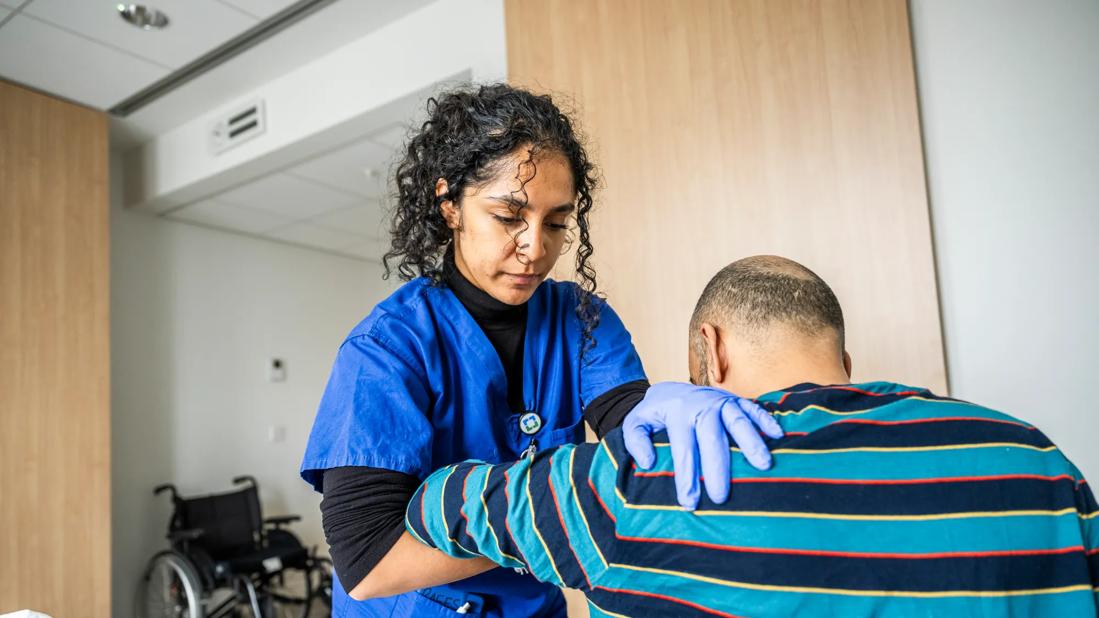Strong bonds and momentous milestones fuel life-changing work

From one clinical experience at Cleveland Clinic Children’s Hospital for Rehabilitation, Allison Citriglia, BSN, RN, CPN, knew she was meant to be a rehabilitation nurse. “I had a rotation here when I was in nursing school at Kent State University and fell in love with rehab nursing,” she recalls.
Advertisement
Cleveland Clinic is a non-profit academic medical center. Advertising on our site helps support our mission. We do not endorse non-Cleveland Clinic products or services. Policy
Over 30 years later, Citriglia manages the hospital’s staff of more than 70 nurses and provides operational oversight of the nursing department, which encompasses three inpatient units (inpatient rehabilitation, medical services and pain rehabilitation), ambulatory nursing, dialysis nursing and nursing in the hospital’s autism school.
“This is a relation-based career where you get to be part of transformational care and see miracles happen,” Citriglia shares.
Rehabilitation nurses specialize in helping patients achieve optimal functionality and independence following an illness, injury or surgery. They play a critical role in healthcare and serve patients of all ages, working in multidisciplinary teams to develop and implement personalized rehabilitation plans.
Citriglia and her colleagues manage pediatric patients with diagnoses such as chronic lung disease, cardiac and gastrointestinal conditions, spinal cord and traumatic brain injuries, stroke recovery, functional neurological symptom disorder and amplified musculoskeletal pain syndrome.
Using strong assessment and clinical skills, nurses provide trauma-informed care, including wound management, skin care, airway maintenance and mobility assistance. They administer medications, monitor vital signs and educate patients and families about care needs before discharge.
“Rehab nurses have one primary objective — get patients back home with their families so they can live a quality life,” Citriglia says.
To help patients reach their goals and promote the highest level of functional independence at discharge, rehab nurses coordinate patient care — modifying plans as needed and developing meaningful relationships with patients and their families.
Advertisement
“Each weekday morning, we do nurse-led rounding with every patient,” Citriglia explains. “We are excellent at partnering with families and making sure they are included in the care plan.”
An important responsibility is teaching patients and their families about the rehabilitation process, home-care techniques and the use of adaptive equipment. “Some patients have tracheostomy tubes or ventilators,” Citriglia says. “Educating families and assessing their knowledge is a huge part of nursing's role and a must for a patient to go home.”
Nurses at Cleveland Clinic Children’s Hospital for Rehabilitation are oriented to all three inpatient units and work alongside nurse practitioners, physician hospitalists, therapists, social workers, care management specialists, dieticians, psychiatrists and psychologists.
“We all have our own spot on the team, but we also work as a whole, which allows us to collaborate and learn from each other,” Citriglia shares. “For example, when we have challenging situations with patients or parents, our social workers offer our nurses education on getting through those difficult moments.”
With significant variety in patient diagnosis and condition, continuing education is imperative. “We are constantly learning because we have to stay up on all diagnoses,” she explains
Staff nurses frequently partner with the department’s clinical nurse educator, skin care nurses, therapists, and others. Nurses receive additional training from caregivers at Cleveland Clinic’s Main Campus as needed, for individualized patient care. Twenty nurses hold specialty certifications and prepare for highly specialized cases.
Advertisement
“We have an active Shared Governance Committee that promotes best practices in rehab nursing care and team members serve on the Pediatric Comfort Care Committee, Pediatric Skin Resource Nurse Committee and Dialysis Affinity Group, just to name a few,” adds Citriglia.
A recent nurse-led continuous improvement project resulted in a new process for tracking family education, including status of outlined education, who received it, who signed off, and more. “Nursing is always collaborating to identify goals for discharge and provide safe, quality care to every patient,” she notes.
Many rehab patients have serious and complex conditions related to their diagnosis so when they meet their goals, it’s momentous.
“Working in this specialty can be hard if you only consider the diagnosis, but when you focus on the gains and the milestones patients achieve as they navigate through their recovery journey, it’s incredibly rewarding,” she shares.
Celebrating patient milestones is something Citriglia cherishes. “We have patient birthday parties and invite other patients, families and caregivers to attend,” she explains. “These are special to the families because it allows them to create memories even though they are hospitalized.”
At discharge, patients are honored with a ‘clap out’ for meeting their homegoing goals. “This line of work is so unique because of the strong bonds you build with patients and their families — you aren’t just caring for the patient, you’re also caring for the family,” she adds. “It’s a truly fulfilling career.”
Advertisement
Advertisement

Compassion, communication and critical thinking are key

How hospitals can weave ethics into daily nursing practice to strengthen patient-centered care

Guiding nurses amid a constantly evolving healthcare landscape

Ideation session generates solutions to medication administration errors

Caregivers spearhead changes that improve patient care, shape hospital culture

Building a culture that supports, engages and empowers nursing staff

Nurses harness cutting-edge technology as a bridge to healing

Optimizing care while protecting patients from life-threatening reactions